Svensk Filmindustri of simply SF, based in Stockholm, is the largest film studio in Sweden and is one of the oldest studios in the world. SF was established on 27 December 1919, and produced classic silent films as Körkarlen/The Phantom Carriage, (Victor Sjöström, 1920), Erotikon/Bounds That Chafe (Mauritz Stiller, 1920) and Gösta Berlings saga/The Saga of Gösta Berling (Mauritz Stiller, 1924). Later, SF produced the films of Ingmar Bergman and the comedies with Nils Poppe. Svensk Filmindustri was a production company, but also a distributor of both Swedish and international films and a cinema chain. SF adopted the current name, SF Studios, in 2016, and is now owned by the Bonnier Group.

Swedish postcard by Nordisk Konst, Stockholm, no. 1097/1. Photo: Svensk Filmindustri. Karin Molander in Erotikon/Bounds That Chafe (Mauritz Stiller, 1920).

Swedish postcard by Nordisk Konst, Stockholm, no. 1097/3. Photo: Svensk Filmindustri. Anders de Wahl and Karin Molander in Erotikon/Bounds That Chafe (Mauritz Stiller, 1920).

Swedish postcard by Nordisk Konst, Stockholm, no. 1097/6. Photo: Svensk Filmindustri. Tora Teje and Lars Hanson in Erotikon/Bounds That Chafe (Mauritz Stiller, 1920).
Erotikon/Bounds That Chafe (Mauritz Stiller, 1920) surely pushed the boundaries of what was acceptable on the screen in 1920: Irene (Tora Teje), the bored wife of a distracted entomologist (Anders de Wahl), pursues a womanising aviator, but she may actually be in love with Preben (Lars Hanson), her husband's best friend. Meanwhile, her husband seems to be getting unusually close with his own niece (Karin Molander). Stiller obviously delights in teasing his audience with each scandalous plot twist and every salacious leer, and the result is a deliciously subversive comedy that was very much ahead of its time.

Swedish postcard by Förlag Nordisk Konst, Stockholm, no. 1117/3. Victor Sjöström and Astrid Holm in Körkarlen/The Phantom Carriage, (Victor Sjöström, 1920).
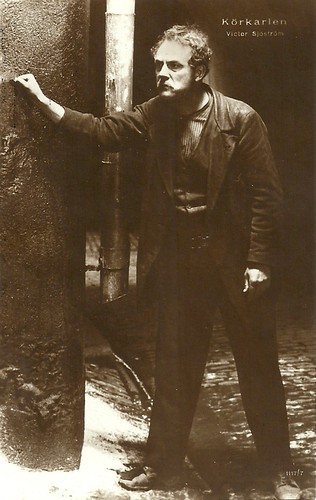
Swedish postcard by Förlag Nordisk Konst, Stockholm, no. 1117/7. Photo: Svensk Filmindustri. Victor Sjöström in Körkarlen/The Phantom Carriage, (Victor Sjöström, 1920).
Körkarlen/The Phantom Carriage, (Victor Sjöström, 1920) is a classic from Swedish silent cinema. Director Victor Sjöström himself played the leading role of the drunkard David Holm. As he is the last one to die on New Year's Eve, Holm is forced to take over the phantom carriage for a full year, collecting the souls of the dead.
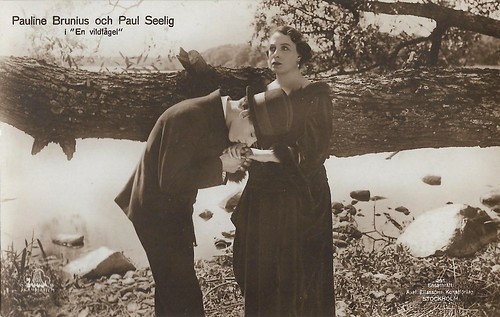
Swedish postcard by Axel Eliassons Konstförlag, Stockholm, no. 291. Photo: Skandia-Film (was now only the distributor) / Svensk Filmindustri. Publicity still for En vildfågel/Give Me My Son (John W. Brunius, 1921) with Pauline Brunius and Paul Seelig.
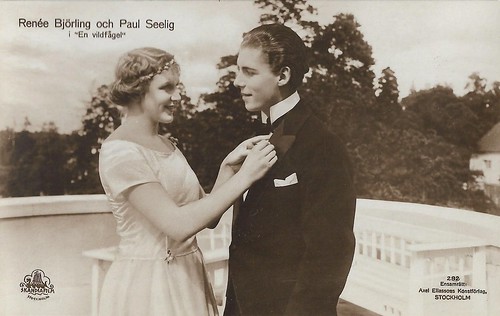
Swedish postcard by Axel Eliassons Konstförlag, Stockholm, no. 292. Photo: Skandia-Film (was now only the distributor) / Svensk Filmindustri. Publicity still for En vildfågel/Give Me My Son (John W. Brunius, 1921) with Renée Björling and Paul Seelig.
The drama En vildfågel/Her adopted Son (John W. Brunius, 1921) was adapted from the play Skeppsbrott (Shipwreck) by Samuel A. Duse. The title means literally 'The Wild Bird'. On 3 October 1921, En vildfågel premiered simultaneously in five cinemas in five different Swedish cities. While the Swedish press was not wild about the plot, it praised Pauline Brunius and newcomer Paul Seelig: "With her strong, mastered and expressive game, Mrs. Brunius wears it all up; she becomes the central figure around which people and events naturally group themselves. Mrs. Brunius with her rich, mature art and her never-failing pace and skill in artistic work is one real treasure for the Swedish film, it's just a shame that she devotes so little of her time to the work in front of the camera." (Marfa in DN).
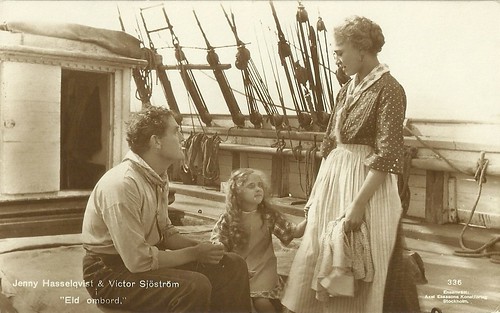
Swedish postcard by Ed. Axel Eliassons Konstförlag, Stockholm, no. 336. Photo: Svensk Filminspelning. Publicity still for Eld ombord/Fire on board (Victor Sjöström, 1923), starring Victor Sjöström and Jenny Hasselqvist.
In Eld ombord/Fire on board (Victor Sjöström, 1923), British actor Matheson Lang stars as Jan Steen, the owner of a ship that returns home. Back home, he finds Dick, his wife's ex-lover in the house. He forces Ann-Britt Steen (Jenny Hasselqvist), the wife, to go on board with him. Dick (Victor Sjöström) gets a new job on a ship, which turns out to be Jan Steen's ship.
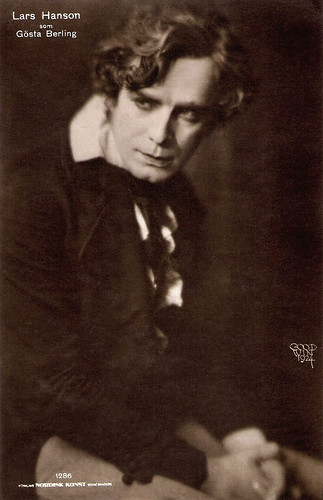
Lars Hanson as Gösta Berling in Gösta Berlings saga (Mauritz Stiller, 1924). Swedish postcard by Förlag Nordisk Konst, Stockholm, no. 1286. Photo: Goodwin, 1924.

Mona Mårtenson. German postcard by Trianon-Film, 1924. Photo: Svenska-Film. Publicity still for Gösta Berlings saga/The Atonement of Gosta Berling (Mauritz Stiller, 1924).
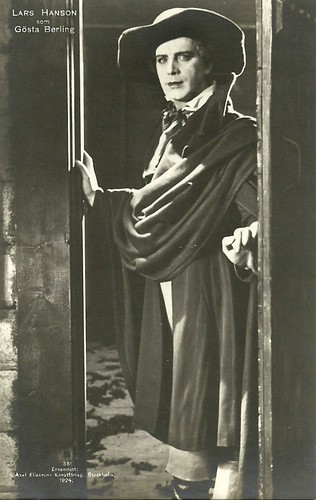
Swedish postcard by Axel Eliassons Konstförlag, Stockholm, no. 381. Again Lars Hanson as the title character in Gösta Berlings saga/The Saga of Gösta Berling (Mauritz Stiller, 1924).
Gösta Berlings saga/The Saga of Gösta Berling (Mauritz Stiller, 1924) was an adaptation of the famous novel by Selma Lagerlöf. Gösta Berling (Lars Hanson) is a young and attractive minister. Because he is an alcoholic and his preaches are far too daring, he is finally defrocked. He leaves the town in disgrace and arrives at countess Marta's manor. His new job there is to be a tutor to countess' beautiful stepdaughter Ebba (Mona Mårtenson). They eventually fall in love with each other. But they don't know that countess hired him only because she has some secret plans of her own... Greta Garbo played a supporting part in this film. Cinematography was by Julius Jaenzon, art direction by Vilhelm Bryde (with Edgar Ulmer collaborating on the set design).
AB Svensk Filmindustri (SF) was founded on 27 December 1919 with the merger of AB Svenska Biografteatern and Filmindustri AB Skandia. The new company had to register and it became urgent to have a new company logo.
The first film poster that used the SF logo was director Mauritz Stiller’s Johan, in 1921. In those early days the logo was very simple with a white S and F against a black background. It was not until the late 1930s that the company changed it to the two thin circle lines with the two beautifully shaped capital letters.
Svensk Filmindustri produced most of the films made by Ingmar Bergman, as well as by other Swedish filmmakers such as Bo Widerberg, Lasse Hallström and Bille August. The majority of film and TV adaptations of the works by children's author Astrid Lindgren have also been produced by SF.
SF also distributes foreign films in the Nordic countries and has deals with Warner Bros., Metro-Goldwyn-Mayer and STX Entertainment in the United States and StudioCanal in France.
SF was owned by Hufvudstaden AB from 1970 until 1973, when it was sold to the newspaper firm Dagens Nyheter. Since 1983 SF has been owned by the Bonnier Group. In 2013, 60% of the cinema division of SF, SF Bio, was sold to the private equity firm Ratos, and since 2017 SF Bio has been owned by AMC Theatres.
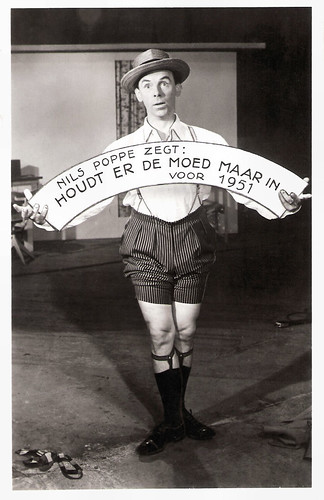
Dutch postcard by Scala Theater, Utrecht, 1950. Photo: publicity still for Tappa inte sugen/Don't give up (Lars-Eric Kjellgren, 1947) with Nils Poppe.
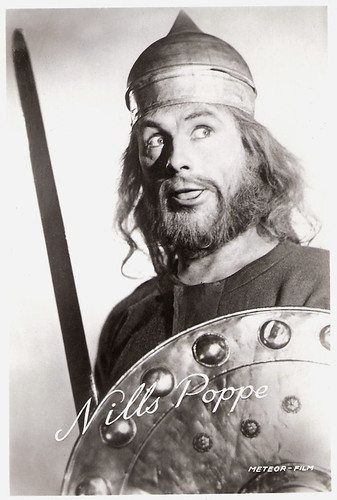
Dutch postcard by Scala Theater, Utrecht, 1949. Photo: Meteor-Film. Publicity still for Ballongen/The Balloon (Göran Gentele, Nils Poppe, 1947) starring Nils Poppe.
Actor, director and screenwriter Nils Poppe (1908–2000) was often referred to as the Swedish Charlie Chaplin. He is internationally best known for his dramatic part as the jester in Ingmar Bergman's Det sjunde inseglet/The Seventh Seal (1957), but in Sweden he was much loved as a comedian and participated in over 50 films and TV series.

Dutch postcard by Semic International, 1971. Photo: publicity still for Pippi Långstrump/Pippi Longstocking (Olle Hellbom, 1969), with Inger Nilsson as Pipi.
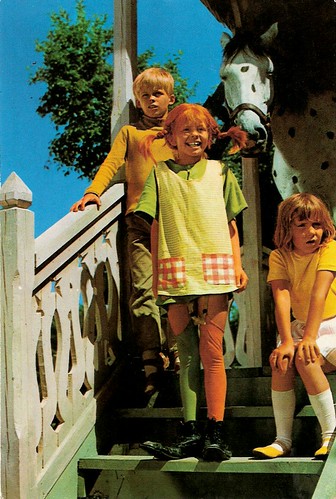
Dutch postcard, 1971. Photo: Semic International. Publicity still for Pippi Långstrump/Pippi Longstocking (Olle Hellbom, 1969) with Inger Nilsson, Maria Persson and Pär Sundberg.
The famous Pippi Langstrump/Pippi Longstocking television series was based on the books by Astrid Lindgren. The first episode was broadcast on Sveriges Radio TV in February 1969. The production was a Swedish-West German co-production and several German actors had roles in the series. As Astrid Lindgren was unhappy with the 1949 adaptation, she wrote the script herself for this version. The series was directed by Olle Hellbom who also directed several other Astrid Lindgren adaptations. Inger Nilsson gave a confident oddball performance as Pippi. The Pippi Langstrump series and two spin-offs became weekend television staples all over Europe throughout the 1970s and 1980s. The series were re-edited as feature films for the cinemas: Pippi Långstrump/Pippi Longstocking (1969), Pippi går ombord/Pippi Goes on Board (1969), Pippi Långstrump på de sju haven/Pippi in the South Seas (1970), På rymmen med Pippi Långstrump/Pippi on the Run (1970), and Här kommer Pippi Långstrump/Here Comes Pippi Longstocking (1973), all directed by Olle Hellbom.
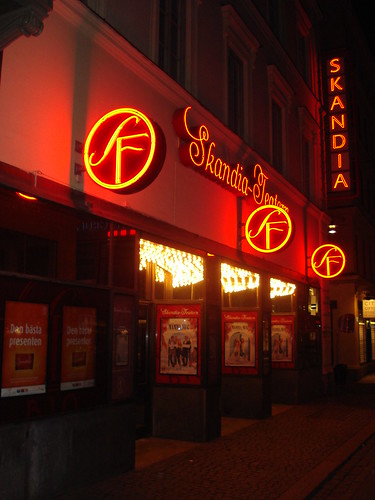
Skandia Cinema by Night, Drottninggatan 82, Stockholm, Sweden. Photo: Paul van Yperen, 2008.
SF cinema Skandia opened on 20 September 1923 with 832 seats. Architect Eric Gunnar Asplund designed a neoclassic movie palace with a semi-atmospheric ceiling. The ceiling had 60 silk covered star shaped lamps, which were extinguished one-by-one before the start of the film. In 1926 a Wurlitzer organ was installed. The theatre currently has 572 seats.
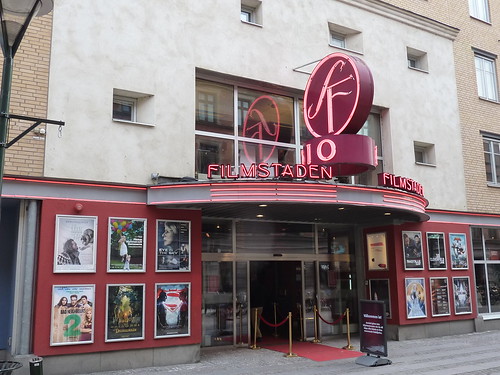
Filmstaden, Malmö, Sweden. Photo: Paul van Yperen, 2016.
The 8-screen multiplex Filmstaden opened in the centre of Malmö on 13 November 1998. Designed by architect Svante Lundquist, the interior was designed by Lisa Mannheimer. The foyer has cherry-wood walls and there is a large neon sign located above the stairs. The upstairs foyer contains an internet coffee-shop and a licenced bar. All eight auditorium are THX-approved and are named after former Malmö cinemas. The largest auditorium, which is named Scania and seats 330, is of particular interest.
Sources: SF Studios, Cinema Treasures, Svensk Film Database, Wikipedia and IMDb.
Silent Films

Swedish postcard by Nordisk Konst, Stockholm, no. 1097/1. Photo: Svensk Filmindustri. Karin Molander in Erotikon/Bounds That Chafe (Mauritz Stiller, 1920).

Swedish postcard by Nordisk Konst, Stockholm, no. 1097/3. Photo: Svensk Filmindustri. Anders de Wahl and Karin Molander in Erotikon/Bounds That Chafe (Mauritz Stiller, 1920).

Swedish postcard by Nordisk Konst, Stockholm, no. 1097/6. Photo: Svensk Filmindustri. Tora Teje and Lars Hanson in Erotikon/Bounds That Chafe (Mauritz Stiller, 1920).
Erotikon/Bounds That Chafe (Mauritz Stiller, 1920) surely pushed the boundaries of what was acceptable on the screen in 1920: Irene (Tora Teje), the bored wife of a distracted entomologist (Anders de Wahl), pursues a womanising aviator, but she may actually be in love with Preben (Lars Hanson), her husband's best friend. Meanwhile, her husband seems to be getting unusually close with his own niece (Karin Molander). Stiller obviously delights in teasing his audience with each scandalous plot twist and every salacious leer, and the result is a deliciously subversive comedy that was very much ahead of its time.

Swedish postcard by Förlag Nordisk Konst, Stockholm, no. 1117/3. Victor Sjöström and Astrid Holm in Körkarlen/The Phantom Carriage, (Victor Sjöström, 1920).

Swedish postcard by Förlag Nordisk Konst, Stockholm, no. 1117/7. Photo: Svensk Filmindustri. Victor Sjöström in Körkarlen/The Phantom Carriage, (Victor Sjöström, 1920).
Körkarlen/The Phantom Carriage, (Victor Sjöström, 1920) is a classic from Swedish silent cinema. Director Victor Sjöström himself played the leading role of the drunkard David Holm. As he is the last one to die on New Year's Eve, Holm is forced to take over the phantom carriage for a full year, collecting the souls of the dead.

Swedish postcard by Axel Eliassons Konstförlag, Stockholm, no. 291. Photo: Skandia-Film (was now only the distributor) / Svensk Filmindustri. Publicity still for En vildfågel/Give Me My Son (John W. Brunius, 1921) with Pauline Brunius and Paul Seelig.

Swedish postcard by Axel Eliassons Konstförlag, Stockholm, no. 292. Photo: Skandia-Film (was now only the distributor) / Svensk Filmindustri. Publicity still for En vildfågel/Give Me My Son (John W. Brunius, 1921) with Renée Björling and Paul Seelig.
The drama En vildfågel/Her adopted Son (John W. Brunius, 1921) was adapted from the play Skeppsbrott (Shipwreck) by Samuel A. Duse. The title means literally 'The Wild Bird'. On 3 October 1921, En vildfågel premiered simultaneously in five cinemas in five different Swedish cities. While the Swedish press was not wild about the plot, it praised Pauline Brunius and newcomer Paul Seelig: "With her strong, mastered and expressive game, Mrs. Brunius wears it all up; she becomes the central figure around which people and events naturally group themselves. Mrs. Brunius with her rich, mature art and her never-failing pace and skill in artistic work is one real treasure for the Swedish film, it's just a shame that she devotes so little of her time to the work in front of the camera." (Marfa in DN).

Swedish postcard by Ed. Axel Eliassons Konstförlag, Stockholm, no. 336. Photo: Svensk Filminspelning. Publicity still for Eld ombord/Fire on board (Victor Sjöström, 1923), starring Victor Sjöström and Jenny Hasselqvist.
In Eld ombord/Fire on board (Victor Sjöström, 1923), British actor Matheson Lang stars as Jan Steen, the owner of a ship that returns home. Back home, he finds Dick, his wife's ex-lover in the house. He forces Ann-Britt Steen (Jenny Hasselqvist), the wife, to go on board with him. Dick (Victor Sjöström) gets a new job on a ship, which turns out to be Jan Steen's ship.

Lars Hanson as Gösta Berling in Gösta Berlings saga (Mauritz Stiller, 1924). Swedish postcard by Förlag Nordisk Konst, Stockholm, no. 1286. Photo: Goodwin, 1924.

Mona Mårtenson. German postcard by Trianon-Film, 1924. Photo: Svenska-Film. Publicity still for Gösta Berlings saga/The Atonement of Gosta Berling (Mauritz Stiller, 1924).

Swedish postcard by Axel Eliassons Konstförlag, Stockholm, no. 381. Again Lars Hanson as the title character in Gösta Berlings saga/The Saga of Gösta Berling (Mauritz Stiller, 1924).
Gösta Berlings saga/The Saga of Gösta Berling (Mauritz Stiller, 1924) was an adaptation of the famous novel by Selma Lagerlöf. Gösta Berling (Lars Hanson) is a young and attractive minister. Because he is an alcoholic and his preaches are far too daring, he is finally defrocked. He leaves the town in disgrace and arrives at countess Marta's manor. His new job there is to be a tutor to countess' beautiful stepdaughter Ebba (Mona Mårtenson). They eventually fall in love with each other. But they don't know that countess hired him only because she has some secret plans of her own... Greta Garbo played a supporting part in this film. Cinematography was by Julius Jaenzon, art direction by Vilhelm Bryde (with Edgar Ulmer collaborating on the set design).
Two beautifully shaped capital letters
AB Svensk Filmindustri (SF) was founded on 27 December 1919 with the merger of AB Svenska Biografteatern and Filmindustri AB Skandia. The new company had to register and it became urgent to have a new company logo.
The first film poster that used the SF logo was director Mauritz Stiller’s Johan, in 1921. In those early days the logo was very simple with a white S and F against a black background. It was not until the late 1930s that the company changed it to the two thin circle lines with the two beautifully shaped capital letters.
Svensk Filmindustri produced most of the films made by Ingmar Bergman, as well as by other Swedish filmmakers such as Bo Widerberg, Lasse Hallström and Bille August. The majority of film and TV adaptations of the works by children's author Astrid Lindgren have also been produced by SF.
SF also distributes foreign films in the Nordic countries and has deals with Warner Bros., Metro-Goldwyn-Mayer and STX Entertainment in the United States and StudioCanal in France.
SF was owned by Hufvudstaden AB from 1970 until 1973, when it was sold to the newspaper firm Dagens Nyheter. Since 1983 SF has been owned by the Bonnier Group. In 2013, 60% of the cinema division of SF, SF Bio, was sold to the private equity firm Ratos, and since 2017 SF Bio has been owned by AMC Theatres.
Sound films

Dutch postcard by Scala Theater, Utrecht, 1950. Photo: publicity still for Tappa inte sugen/Don't give up (Lars-Eric Kjellgren, 1947) with Nils Poppe.

Dutch postcard by Scala Theater, Utrecht, 1949. Photo: Meteor-Film. Publicity still for Ballongen/The Balloon (Göran Gentele, Nils Poppe, 1947) starring Nils Poppe.
Actor, director and screenwriter Nils Poppe (1908–2000) was often referred to as the Swedish Charlie Chaplin. He is internationally best known for his dramatic part as the jester in Ingmar Bergman's Det sjunde inseglet/The Seventh Seal (1957), but in Sweden he was much loved as a comedian and participated in over 50 films and TV series.

Dutch postcard by Semic International, 1971. Photo: publicity still for Pippi Långstrump/Pippi Longstocking (Olle Hellbom, 1969), with Inger Nilsson as Pipi.

Dutch postcard, 1971. Photo: Semic International. Publicity still for Pippi Långstrump/Pippi Longstocking (Olle Hellbom, 1969) with Inger Nilsson, Maria Persson and Pär Sundberg.
The famous Pippi Langstrump/Pippi Longstocking television series was based on the books by Astrid Lindgren. The first episode was broadcast on Sveriges Radio TV in February 1969. The production was a Swedish-West German co-production and several German actors had roles in the series. As Astrid Lindgren was unhappy with the 1949 adaptation, she wrote the script herself for this version. The series was directed by Olle Hellbom who also directed several other Astrid Lindgren adaptations. Inger Nilsson gave a confident oddball performance as Pippi. The Pippi Langstrump series and two spin-offs became weekend television staples all over Europe throughout the 1970s and 1980s. The series were re-edited as feature films for the cinemas: Pippi Långstrump/Pippi Longstocking (1969), Pippi går ombord/Pippi Goes on Board (1969), Pippi Långstrump på de sju haven/Pippi in the South Seas (1970), På rymmen med Pippi Långstrump/Pippi on the Run (1970), and Här kommer Pippi Långstrump/Here Comes Pippi Longstocking (1973), all directed by Olle Hellbom.
SF Cinemas

Skandia Cinema by Night, Drottninggatan 82, Stockholm, Sweden. Photo: Paul van Yperen, 2008.
SF cinema Skandia opened on 20 September 1923 with 832 seats. Architect Eric Gunnar Asplund designed a neoclassic movie palace with a semi-atmospheric ceiling. The ceiling had 60 silk covered star shaped lamps, which were extinguished one-by-one before the start of the film. In 1926 a Wurlitzer organ was installed. The theatre currently has 572 seats.

Filmstaden, Malmö, Sweden. Photo: Paul van Yperen, 2016.
The 8-screen multiplex Filmstaden opened in the centre of Malmö on 13 November 1998. Designed by architect Svante Lundquist, the interior was designed by Lisa Mannheimer. The foyer has cherry-wood walls and there is a large neon sign located above the stairs. The upstairs foyer contains an internet coffee-shop and a licenced bar. All eight auditorium are THX-approved and are named after former Malmö cinemas. The largest auditorium, which is named Scania and seats 330, is of particular interest.
Sources: SF Studios, Cinema Treasures, Svensk Film Database, Wikipedia and IMDb.
No comments:
Post a Comment